XN7005 Nutritional Assessment: Weight Loss Program Case Study Analysis
VerifiedAdded on 2023/01/16
|20
|5702
|38
Case Study
AI Summary
This case study presents a weight loss program designed for a 40-year-old man, Mr. John, diagnosed with hypertension and diabetes due to obesity. The study begins with an abstract summarizing the program's goals and methods, followed by an introduction detailing Mr. John's health issues and lifestyle. The methods section describes the use of a food diary, physical activity journal, and predictive equations for energy expenditure to assess Mr. John's current state. The results section provides data on his dietary intake, activity levels, and anthropometric measurements. The discussion analyzes the assessment results, discusses the reliability of the methods, and offers recommendations for future monitoring. A review of literature on food intake regulation is included to support the program's strategies. The study aims to help Mr. John regulate his weight through a structured diet plan and increased physical activity, including suggestions for yoga, aerobics, and Zumba classes. The dietary plan includes specific meals for each day of the week, focusing on balanced nutrition and calorie control. The study uses predictive equations like Mifflin-St Jeor and Harris Benedict to calculate resting metabolic rate. Anthropometric measurements were used to assess his body composition, including BMI. The case study concludes by highlighting the importance of lifestyle changes for managing weight and related health conditions. The study shows that Mr. John's weight was gradually managed by the program and that he was able to follow the dietary plan on a regular basis.
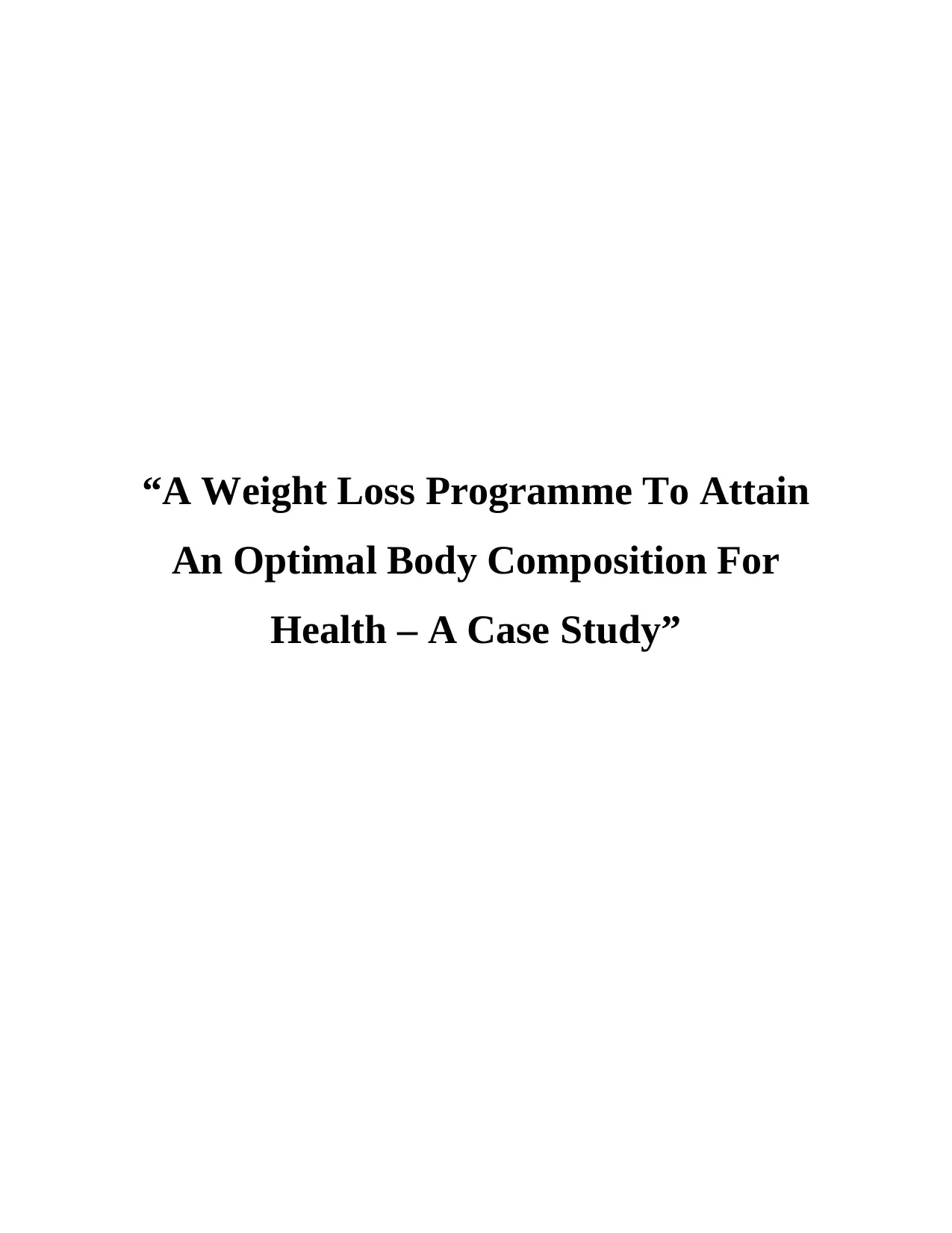
“A Weight Loss Programme To Attain
An Optimal Body Composition For
Health – A Case Study”
An Optimal Body Composition For
Health – A Case Study”
Paraphrase This Document
Need a fresh take? Get an instant paraphrase of this document with our AI Paraphraser
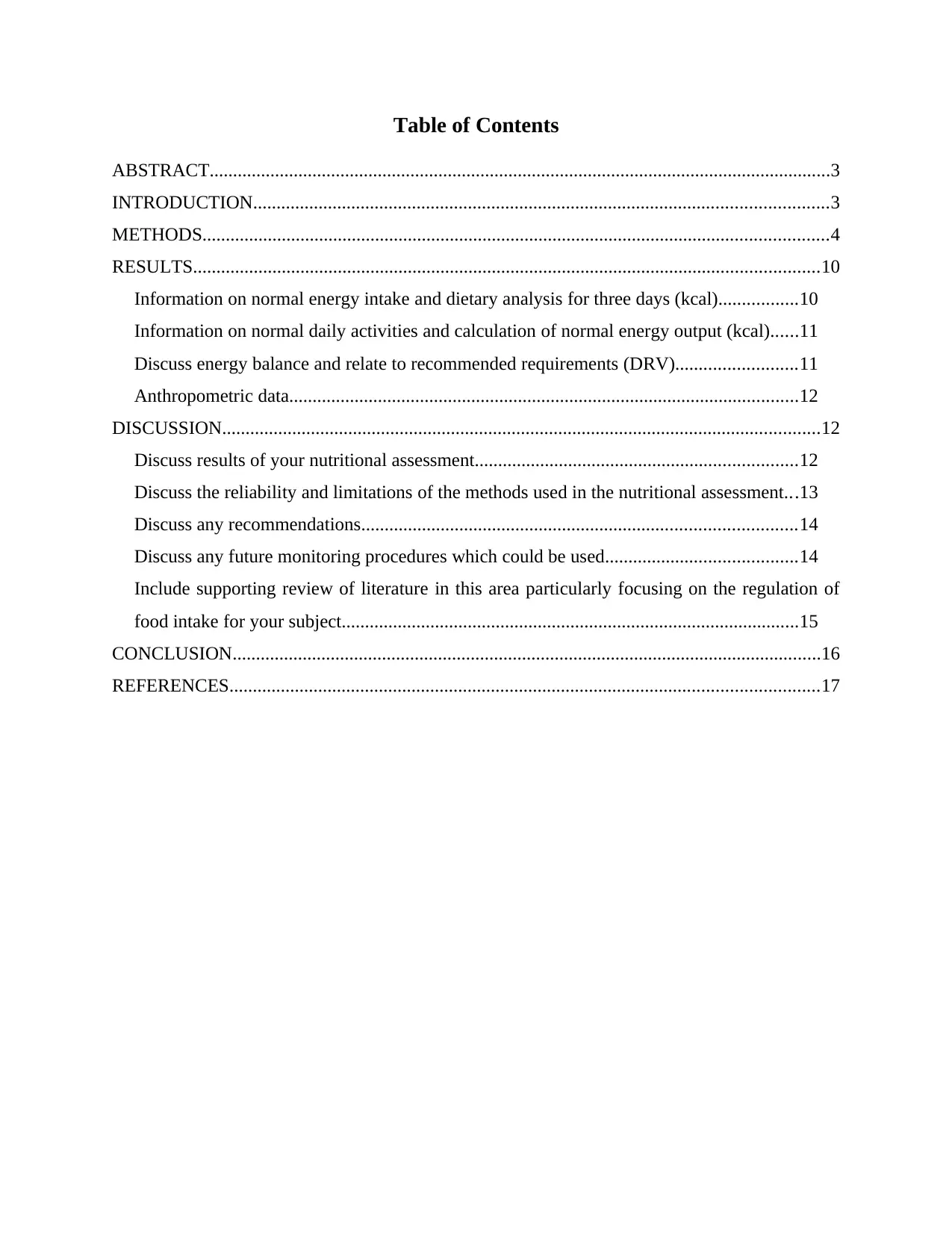
Table of Contents
ABSTRACT.....................................................................................................................................3
INTRODUCTION...........................................................................................................................3
METHODS......................................................................................................................................4
RESULTS......................................................................................................................................10
Information on normal energy intake and dietary analysis for three days (kcal).................10
Information on normal daily activities and calculation of normal energy output (kcal)......11
Discuss energy balance and relate to recommended requirements (DRV)..........................11
Anthropometric data.............................................................................................................12
DISCUSSION................................................................................................................................12
Discuss results of your nutritional assessment.....................................................................12
Discuss the reliability and limitations of the methods used in the nutritional assessment...13
Discuss any recommendations.............................................................................................14
Discuss any future monitoring procedures which could be used.........................................14
Include supporting review of literature in this area particularly focusing on the regulation of
food intake for your subject..................................................................................................15
CONCLUSION..............................................................................................................................16
REFERENCES..............................................................................................................................17
ABSTRACT.....................................................................................................................................3
INTRODUCTION...........................................................................................................................3
METHODS......................................................................................................................................4
RESULTS......................................................................................................................................10
Information on normal energy intake and dietary analysis for three days (kcal).................10
Information on normal daily activities and calculation of normal energy output (kcal)......11
Discuss energy balance and relate to recommended requirements (DRV)..........................11
Anthropometric data.............................................................................................................12
DISCUSSION................................................................................................................................12
Discuss results of your nutritional assessment.....................................................................12
Discuss the reliability and limitations of the methods used in the nutritional assessment...13
Discuss any recommendations.............................................................................................14
Discuss any future monitoring procedures which could be used.........................................14
Include supporting review of literature in this area particularly focusing on the regulation of
food intake for your subject..................................................................................................15
CONCLUSION..............................................................................................................................16
REFERENCES..............................................................................................................................17

⊘ This is a preview!⊘
Do you want full access?
Subscribe today to unlock all pages.

Trusted by 1+ million students worldwide
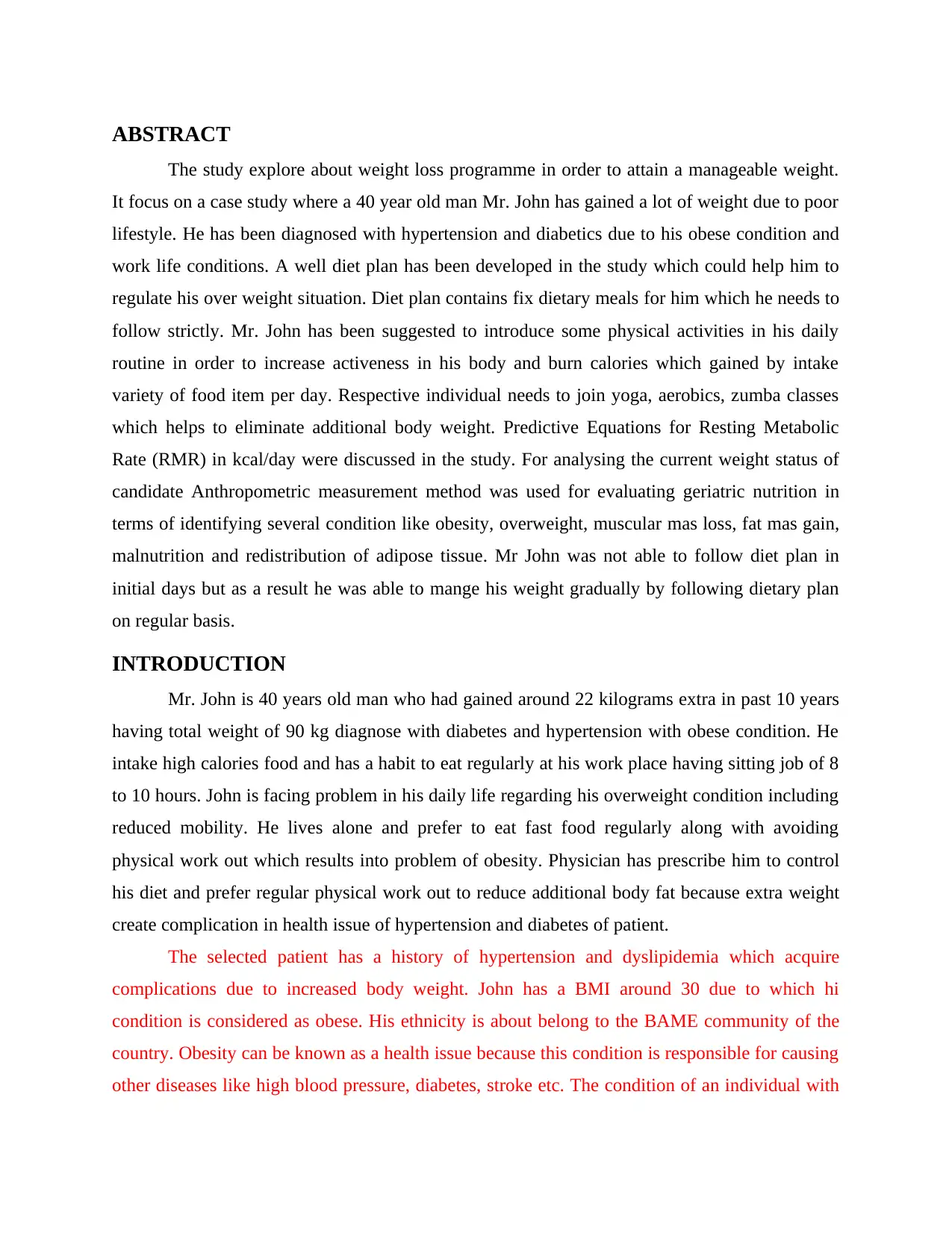
ABSTRACT
The study explore about weight loss programme in order to attain a manageable weight.
It focus on a case study where a 40 year old man Mr. John has gained a lot of weight due to poor
lifestyle. He has been diagnosed with hypertension and diabetics due to his obese condition and
work life conditions. A well diet plan has been developed in the study which could help him to
regulate his over weight situation. Diet plan contains fix dietary meals for him which he needs to
follow strictly. Mr. John has been suggested to introduce some physical activities in his daily
routine in order to increase activeness in his body and burn calories which gained by intake
variety of food item per day. Respective individual needs to join yoga, aerobics, zumba classes
which helps to eliminate additional body weight. Predictive Equations for Resting Metabolic
Rate (RMR) in kcal/day were discussed in the study. For analysing the current weight status of
candidate Anthropometric measurement method was used for evaluating geriatric nutrition in
terms of identifying several condition like obesity, overweight, muscular mas loss, fat mas gain,
malnutrition and redistribution of adipose tissue. Mr John was not able to follow diet plan in
initial days but as a result he was able to mange his weight gradually by following dietary plan
on regular basis.
INTRODUCTION
Mr. John is 40 years old man who had gained around 22 kilograms extra in past 10 years
having total weight of 90 kg diagnose with diabetes and hypertension with obese condition. He
intake high calories food and has a habit to eat regularly at his work place having sitting job of 8
to 10 hours. John is facing problem in his daily life regarding his overweight condition including
reduced mobility. He lives alone and prefer to eat fast food regularly along with avoiding
physical work out which results into problem of obesity. Physician has prescribe him to control
his diet and prefer regular physical work out to reduce additional body fat because extra weight
create complication in health issue of hypertension and diabetes of patient.
The selected patient has a history of hypertension and dyslipidemia which acquire
complications due to increased body weight. John has a BMI around 30 due to which hi
condition is considered as obese. His ethnicity is about belong to the BAME community of the
country. Obesity can be known as a health issue because this condition is responsible for causing
other diseases like high blood pressure, diabetes, stroke etc. The condition of an individual with
The study explore about weight loss programme in order to attain a manageable weight.
It focus on a case study where a 40 year old man Mr. John has gained a lot of weight due to poor
lifestyle. He has been diagnosed with hypertension and diabetics due to his obese condition and
work life conditions. A well diet plan has been developed in the study which could help him to
regulate his over weight situation. Diet plan contains fix dietary meals for him which he needs to
follow strictly. Mr. John has been suggested to introduce some physical activities in his daily
routine in order to increase activeness in his body and burn calories which gained by intake
variety of food item per day. Respective individual needs to join yoga, aerobics, zumba classes
which helps to eliminate additional body weight. Predictive Equations for Resting Metabolic
Rate (RMR) in kcal/day were discussed in the study. For analysing the current weight status of
candidate Anthropometric measurement method was used for evaluating geriatric nutrition in
terms of identifying several condition like obesity, overweight, muscular mas loss, fat mas gain,
malnutrition and redistribution of adipose tissue. Mr John was not able to follow diet plan in
initial days but as a result he was able to mange his weight gradually by following dietary plan
on regular basis.
INTRODUCTION
Mr. John is 40 years old man who had gained around 22 kilograms extra in past 10 years
having total weight of 90 kg diagnose with diabetes and hypertension with obese condition. He
intake high calories food and has a habit to eat regularly at his work place having sitting job of 8
to 10 hours. John is facing problem in his daily life regarding his overweight condition including
reduced mobility. He lives alone and prefer to eat fast food regularly along with avoiding
physical work out which results into problem of obesity. Physician has prescribe him to control
his diet and prefer regular physical work out to reduce additional body fat because extra weight
create complication in health issue of hypertension and diabetes of patient.
The selected patient has a history of hypertension and dyslipidemia which acquire
complications due to increased body weight. John has a BMI around 30 due to which hi
condition is considered as obese. His ethnicity is about belong to the BAME community of the
country. Obesity can be known as a health issue because this condition is responsible for causing
other diseases like high blood pressure, diabetes, stroke etc. The condition of an individual with
Paraphrase This Document
Need a fresh take? Get an instant paraphrase of this document with our AI Paraphraser
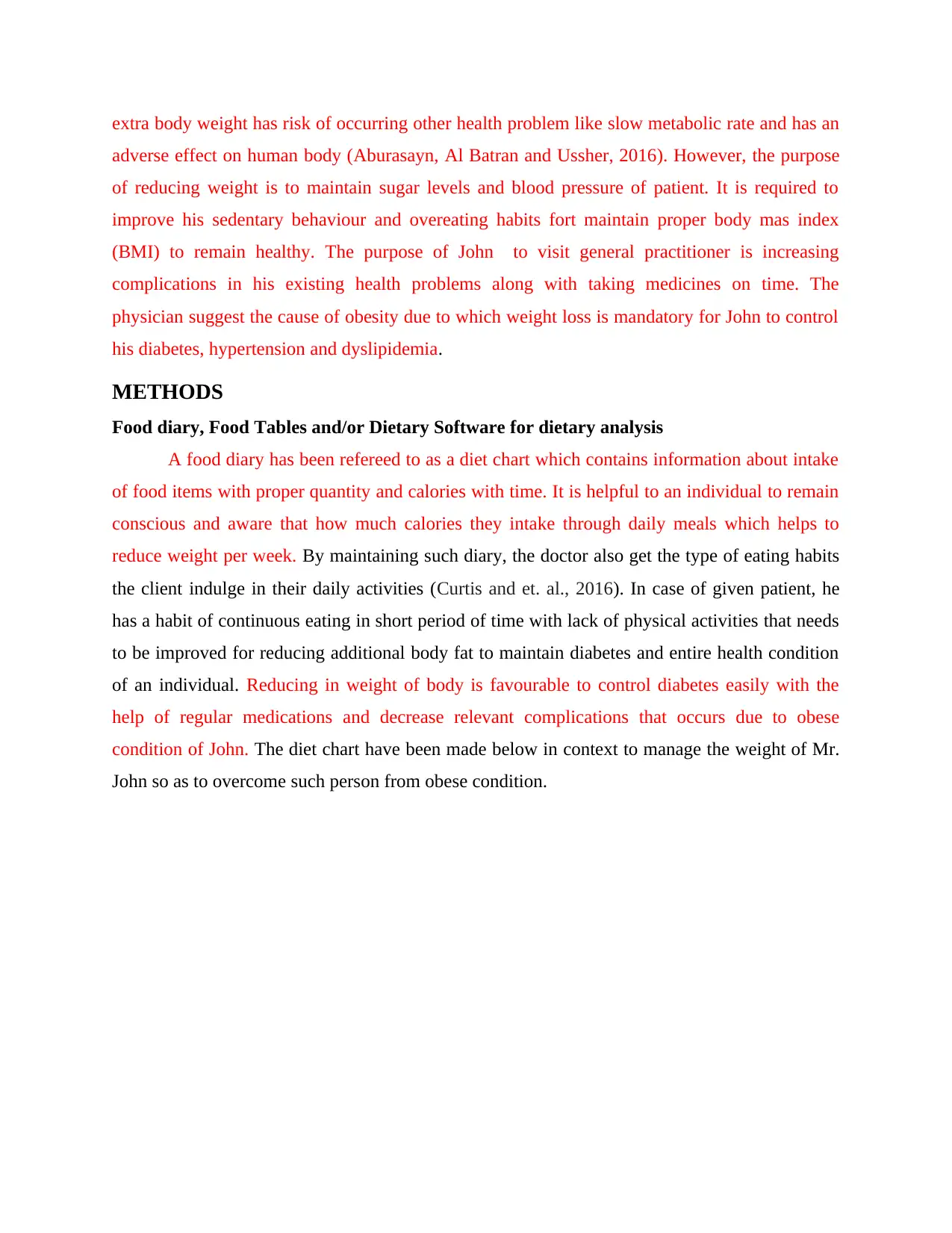
extra body weight has risk of occurring other health problem like slow metabolic rate and has an
adverse effect on human body (Aburasayn, Al Batran and Ussher, 2016). However, the purpose
of reducing weight is to maintain sugar levels and blood pressure of patient. It is required to
improve his sedentary behaviour and overeating habits fort maintain proper body mas index
(BMI) to remain healthy. The purpose of John to visit general practitioner is increasing
complications in his existing health problems along with taking medicines on time. The
physician suggest the cause of obesity due to which weight loss is mandatory for John to control
his diabetes, hypertension and dyslipidemia.
METHODS
Food diary, Food Tables and/or Dietary Software for dietary analysis
A food diary has been refereed to as a diet chart which contains information about intake
of food items with proper quantity and calories with time. It is helpful to an individual to remain
conscious and aware that how much calories they intake through daily meals which helps to
reduce weight per week. By maintaining such diary, the doctor also get the type of eating habits
the client indulge in their daily activities (Curtis and et. al., 2016). In case of given patient, he
has a habit of continuous eating in short period of time with lack of physical activities that needs
to be improved for reducing additional body fat to maintain diabetes and entire health condition
of an individual. Reducing in weight of body is favourable to control diabetes easily with the
help of regular medications and decrease relevant complications that occurs due to obese
condition of John. The diet chart have been made below in context to manage the weight of Mr.
John so as to overcome such person from obese condition.
adverse effect on human body (Aburasayn, Al Batran and Ussher, 2016). However, the purpose
of reducing weight is to maintain sugar levels and blood pressure of patient. It is required to
improve his sedentary behaviour and overeating habits fort maintain proper body mas index
(BMI) to remain healthy. The purpose of John to visit general practitioner is increasing
complications in his existing health problems along with taking medicines on time. The
physician suggest the cause of obesity due to which weight loss is mandatory for John to control
his diabetes, hypertension and dyslipidemia.
METHODS
Food diary, Food Tables and/or Dietary Software for dietary analysis
A food diary has been refereed to as a diet chart which contains information about intake
of food items with proper quantity and calories with time. It is helpful to an individual to remain
conscious and aware that how much calories they intake through daily meals which helps to
reduce weight per week. By maintaining such diary, the doctor also get the type of eating habits
the client indulge in their daily activities (Curtis and et. al., 2016). In case of given patient, he
has a habit of continuous eating in short period of time with lack of physical activities that needs
to be improved for reducing additional body fat to maintain diabetes and entire health condition
of an individual. Reducing in weight of body is favourable to control diabetes easily with the
help of regular medications and decrease relevant complications that occurs due to obese
condition of John. The diet chart have been made below in context to manage the weight of Mr.
John so as to overcome such person from obese condition.
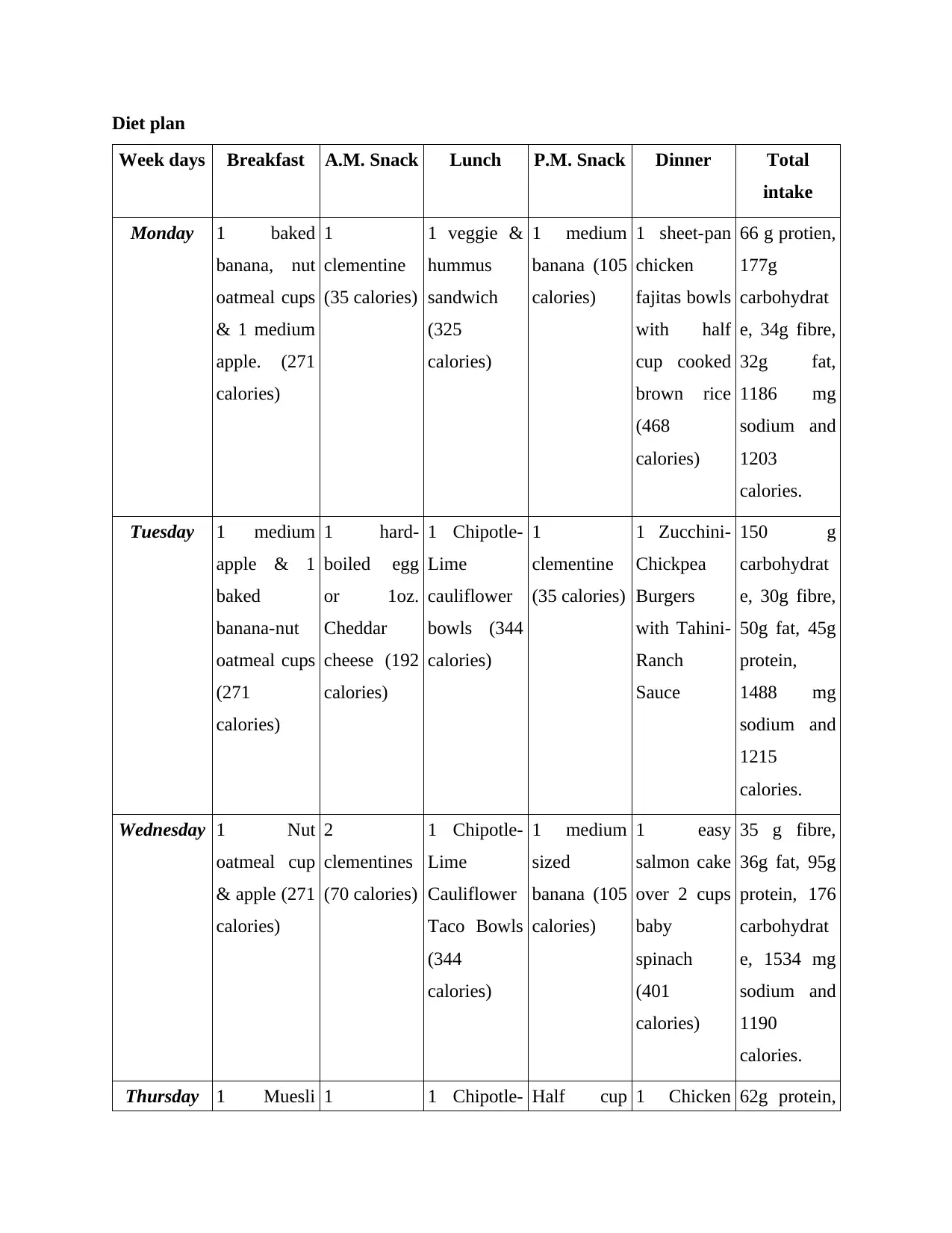
Diet plan
Week days Breakfast A.M. Snack Lunch P.M. Snack Dinner Total
intake
Monday 1 baked
banana, nut
oatmeal cups
& 1 medium
apple. (271
calories)
1
clementine
(35 calories)
1 veggie &
hummus
sandwich
(325
calories)
1 medium
banana (105
calories)
1 sheet-pan
chicken
fajitas bowls
with half
cup cooked
brown rice
(468
calories)
66 g protien,
177g
carbohydrat
e, 34g fibre,
32g fat,
1186 mg
sodium and
1203
calories.
Tuesday 1 medium
apple & 1
baked
banana-nut
oatmeal cups
(271
calories)
1 hard-
boiled egg
or 1oz.
Cheddar
cheese (192
calories)
1 Chipotle-
Lime
cauliflower
bowls (344
calories)
1
clementine
(35 calories)
1 Zucchini-
Chickpea
Burgers
with Tahini-
Ranch
Sauce
150 g
carbohydrat
e, 30g fibre,
50g fat, 45g
protein,
1488 mg
sodium and
1215
calories.
Wednesday 1 Nut
oatmeal cup
& apple (271
calories)
2
clementines
(70 calories)
1 Chipotle-
Lime
Cauliflower
Taco Bowls
(344
calories)
1 medium
sized
banana (105
calories)
1 easy
salmon cake
over 2 cups
baby
spinach
(401
calories)
35 g fibre,
36g fat, 95g
protein, 176
carbohydrat
e, 1534 mg
sodium and
1190
calories.
Thursday 1 Muesli 1 1 Chipotle- Half cup 1 Chicken 62g protein,
Week days Breakfast A.M. Snack Lunch P.M. Snack Dinner Total
intake
Monday 1 baked
banana, nut
oatmeal cups
& 1 medium
apple. (271
calories)
1
clementine
(35 calories)
1 veggie &
hummus
sandwich
(325
calories)
1 medium
banana (105
calories)
1 sheet-pan
chicken
fajitas bowls
with half
cup cooked
brown rice
(468
calories)
66 g protien,
177g
carbohydrat
e, 34g fibre,
32g fat,
1186 mg
sodium and
1203
calories.
Tuesday 1 medium
apple & 1
baked
banana-nut
oatmeal cups
(271
calories)
1 hard-
boiled egg
or 1oz.
Cheddar
cheese (192
calories)
1 Chipotle-
Lime
cauliflower
bowls (344
calories)
1
clementine
(35 calories)
1 Zucchini-
Chickpea
Burgers
with Tahini-
Ranch
Sauce
150 g
carbohydrat
e, 30g fibre,
50g fat, 45g
protein,
1488 mg
sodium and
1215
calories.
Wednesday 1 Nut
oatmeal cup
& apple (271
calories)
2
clementines
(70 calories)
1 Chipotle-
Lime
Cauliflower
Taco Bowls
(344
calories)
1 medium
sized
banana (105
calories)
1 easy
salmon cake
over 2 cups
baby
spinach
(401
calories)
35 g fibre,
36g fat, 95g
protein, 176
carbohydrat
e, 1534 mg
sodium and
1190
calories.
Thursday 1 Muesli 1 1 Chipotle- Half cup 1 Chicken 62g protein,
⊘ This is a preview!⊘
Do you want full access?
Subscribe today to unlock all pages.

Trusted by 1+ million students worldwide
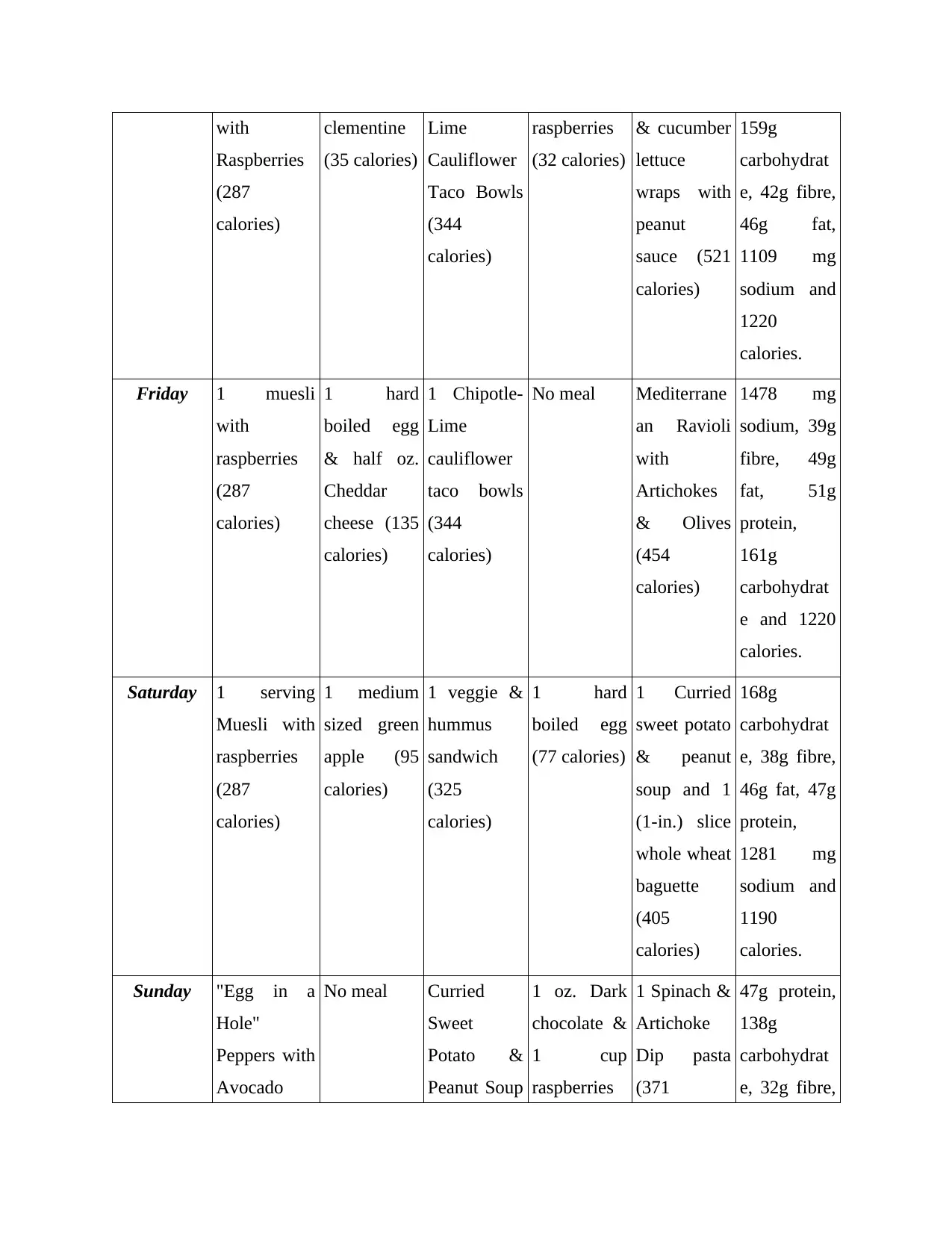
with
Raspberries
(287
calories)
clementine
(35 calories)
Lime
Cauliflower
Taco Bowls
(344
calories)
raspberries
(32 calories)
& cucumber
lettuce
wraps with
peanut
sauce (521
calories)
159g
carbohydrat
e, 42g fibre,
46g fat,
1109 mg
sodium and
1220
calories.
Friday 1 muesli
with
raspberries
(287
calories)
1 hard
boiled egg
& half oz.
Cheddar
cheese (135
calories)
1 Chipotle-
Lime
cauliflower
taco bowls
(344
calories)
No meal Mediterrane
an Ravioli
with
Artichokes
& Olives
(454
calories)
1478 mg
sodium, 39g
fibre, 49g
fat, 51g
protein,
161g
carbohydrat
e and 1220
calories.
Saturday 1 serving
Muesli with
raspberries
(287
calories)
1 medium
sized green
apple (95
calories)
1 veggie &
hummus
sandwich
(325
calories)
1 hard
boiled egg
(77 calories)
1 Curried
sweet potato
& peanut
soup and 1
(1-in.) slice
whole wheat
baguette
(405
calories)
168g
carbohydrat
e, 38g fibre,
46g fat, 47g
protein,
1281 mg
sodium and
1190
calories.
Sunday "Egg in a
Hole"
Peppers with
Avocado
No meal Curried
Sweet
Potato &
Peanut Soup
1 oz. Dark
chocolate &
1 cup
raspberries
1 Spinach &
Artichoke
Dip pasta
(371
47g protein,
138g
carbohydrat
e, 32g fibre,
Raspberries
(287
calories)
clementine
(35 calories)
Lime
Cauliflower
Taco Bowls
(344
calories)
raspberries
(32 calories)
& cucumber
lettuce
wraps with
peanut
sauce (521
calories)
159g
carbohydrat
e, 42g fibre,
46g fat,
1109 mg
sodium and
1220
calories.
Friday 1 muesli
with
raspberries
(287
calories)
1 hard
boiled egg
& half oz.
Cheddar
cheese (135
calories)
1 Chipotle-
Lime
cauliflower
taco bowls
(344
calories)
No meal Mediterrane
an Ravioli
with
Artichokes
& Olives
(454
calories)
1478 mg
sodium, 39g
fibre, 49g
fat, 51g
protein,
161g
carbohydrat
e and 1220
calories.
Saturday 1 serving
Muesli with
raspberries
(287
calories)
1 medium
sized green
apple (95
calories)
1 veggie &
hummus
sandwich
(325
calories)
1 hard
boiled egg
(77 calories)
1 Curried
sweet potato
& peanut
soup and 1
(1-in.) slice
whole wheat
baguette
(405
calories)
168g
carbohydrat
e, 38g fibre,
46g fat, 47g
protein,
1281 mg
sodium and
1190
calories.
Sunday "Egg in a
Hole"
Peppers with
Avocado
No meal Curried
Sweet
Potato &
Peanut Soup
1 oz. Dark
chocolate &
1 cup
raspberries
1 Spinach &
Artichoke
Dip pasta
(371
47g protein,
138g
carbohydrat
e, 32g fibre,
Paraphrase This Document
Need a fresh take? Get an instant paraphrase of this document with our AI Paraphraser
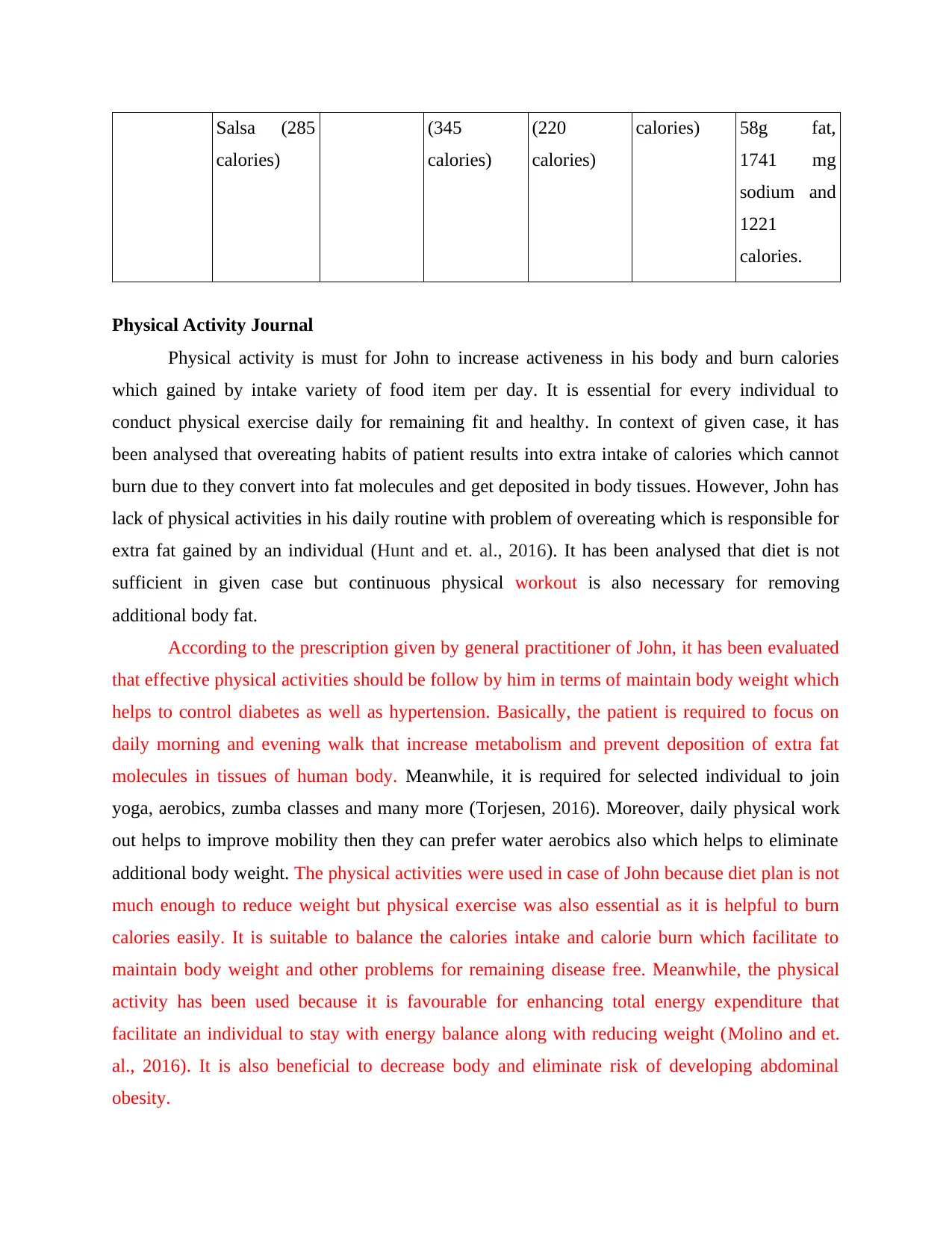
Salsa (285
calories)
(345
calories)
(220
calories)
calories) 58g fat,
1741 mg
sodium and
1221
calories.
Physical Activity Journal
Physical activity is must for John to increase activeness in his body and burn calories
which gained by intake variety of food item per day. It is essential for every individual to
conduct physical exercise daily for remaining fit and healthy. In context of given case, it has
been analysed that overeating habits of patient results into extra intake of calories which cannot
burn due to they convert into fat molecules and get deposited in body tissues. However, John has
lack of physical activities in his daily routine with problem of overeating which is responsible for
extra fat gained by an individual (Hunt and et. al., 2016). It has been analysed that diet is not
sufficient in given case but continuous physical workout is also necessary for removing
additional body fat.
According to the prescription given by general practitioner of John, it has been evaluated
that effective physical activities should be follow by him in terms of maintain body weight which
helps to control diabetes as well as hypertension. Basically, the patient is required to focus on
daily morning and evening walk that increase metabolism and prevent deposition of extra fat
molecules in tissues of human body. Meanwhile, it is required for selected individual to join
yoga, aerobics, zumba classes and many more (Torjesen, 2016). Moreover, daily physical work
out helps to improve mobility then they can prefer water aerobics also which helps to eliminate
additional body weight. The physical activities were used in case of John because diet plan is not
much enough to reduce weight but physical exercise was also essential as it is helpful to burn
calories easily. It is suitable to balance the calories intake and calorie burn which facilitate to
maintain body weight and other problems for remaining disease free. Meanwhile, the physical
activity has been used because it is favourable for enhancing total energy expenditure that
facilitate an individual to stay with energy balance along with reducing weight (Molino and et.
al., 2016). It is also beneficial to decrease body and eliminate risk of developing abdominal
obesity.
calories)
(345
calories)
(220
calories)
calories) 58g fat,
1741 mg
sodium and
1221
calories.
Physical Activity Journal
Physical activity is must for John to increase activeness in his body and burn calories
which gained by intake variety of food item per day. It is essential for every individual to
conduct physical exercise daily for remaining fit and healthy. In context of given case, it has
been analysed that overeating habits of patient results into extra intake of calories which cannot
burn due to they convert into fat molecules and get deposited in body tissues. However, John has
lack of physical activities in his daily routine with problem of overeating which is responsible for
extra fat gained by an individual (Hunt and et. al., 2016). It has been analysed that diet is not
sufficient in given case but continuous physical workout is also necessary for removing
additional body fat.
According to the prescription given by general practitioner of John, it has been evaluated
that effective physical activities should be follow by him in terms of maintain body weight which
helps to control diabetes as well as hypertension. Basically, the patient is required to focus on
daily morning and evening walk that increase metabolism and prevent deposition of extra fat
molecules in tissues of human body. Meanwhile, it is required for selected individual to join
yoga, aerobics, zumba classes and many more (Torjesen, 2016). Moreover, daily physical work
out helps to improve mobility then they can prefer water aerobics also which helps to eliminate
additional body weight. The physical activities were used in case of John because diet plan is not
much enough to reduce weight but physical exercise was also essential as it is helpful to burn
calories easily. It is suitable to balance the calories intake and calorie burn which facilitate to
maintain body weight and other problems for remaining disease free. Meanwhile, the physical
activity has been used because it is favourable for enhancing total energy expenditure that
facilitate an individual to stay with energy balance along with reducing weight (Molino and et.
al., 2016). It is also beneficial to decrease body and eliminate risk of developing abdominal
obesity.

Predictive equations for energy expenditure
Predictive Equations for Resting Metabolic Rate (RMR) in kcal/day. All equations use
weight in kilograms (kg), height in centimetres (cm) except the WHO/FAO/UNU equation that
uses height in meters (m).
Mifflin-St Jeor
Men: RMR = 9.99 X weight + 6.25 X height – 4.92 X age + 5
Women: RMR = 9.99 X weight + 6.25 X height – 4.92 X age – 161
Harris Benedict
Men: RMR = 66.47 + 13.75 X weight + 5.0 X height – 6.75 X age
Women: RMR = 655.09 + 9.56 X weight + 1.84 X height – 4.67 X age
Owen
Men: RMR = 879 + 10.2 X weight
Women: RMR = 795 + 7.18 X weight
WHO or FAO or UNU
Weight only:
Age (yr)
Men
18-30 RMR = 15.3 X weight + 679
31-60 RMR = 11.6 X weight + 879
>60 RMR = 13.5 X weight + 487
Women
Predictive Equations for Resting Metabolic Rate (RMR) in kcal/day. All equations use
weight in kilograms (kg), height in centimetres (cm) except the WHO/FAO/UNU equation that
uses height in meters (m).
Mifflin-St Jeor
Men: RMR = 9.99 X weight + 6.25 X height – 4.92 X age + 5
Women: RMR = 9.99 X weight + 6.25 X height – 4.92 X age – 161
Harris Benedict
Men: RMR = 66.47 + 13.75 X weight + 5.0 X height – 6.75 X age
Women: RMR = 655.09 + 9.56 X weight + 1.84 X height – 4.67 X age
Owen
Men: RMR = 879 + 10.2 X weight
Women: RMR = 795 + 7.18 X weight
WHO or FAO or UNU
Weight only:
Age (yr)
Men
18-30 RMR = 15.3 X weight + 679
31-60 RMR = 11.6 X weight + 879
>60 RMR = 13.5 X weight + 487
Women
⊘ This is a preview!⊘
Do you want full access?
Subscribe today to unlock all pages.

Trusted by 1+ million students worldwide
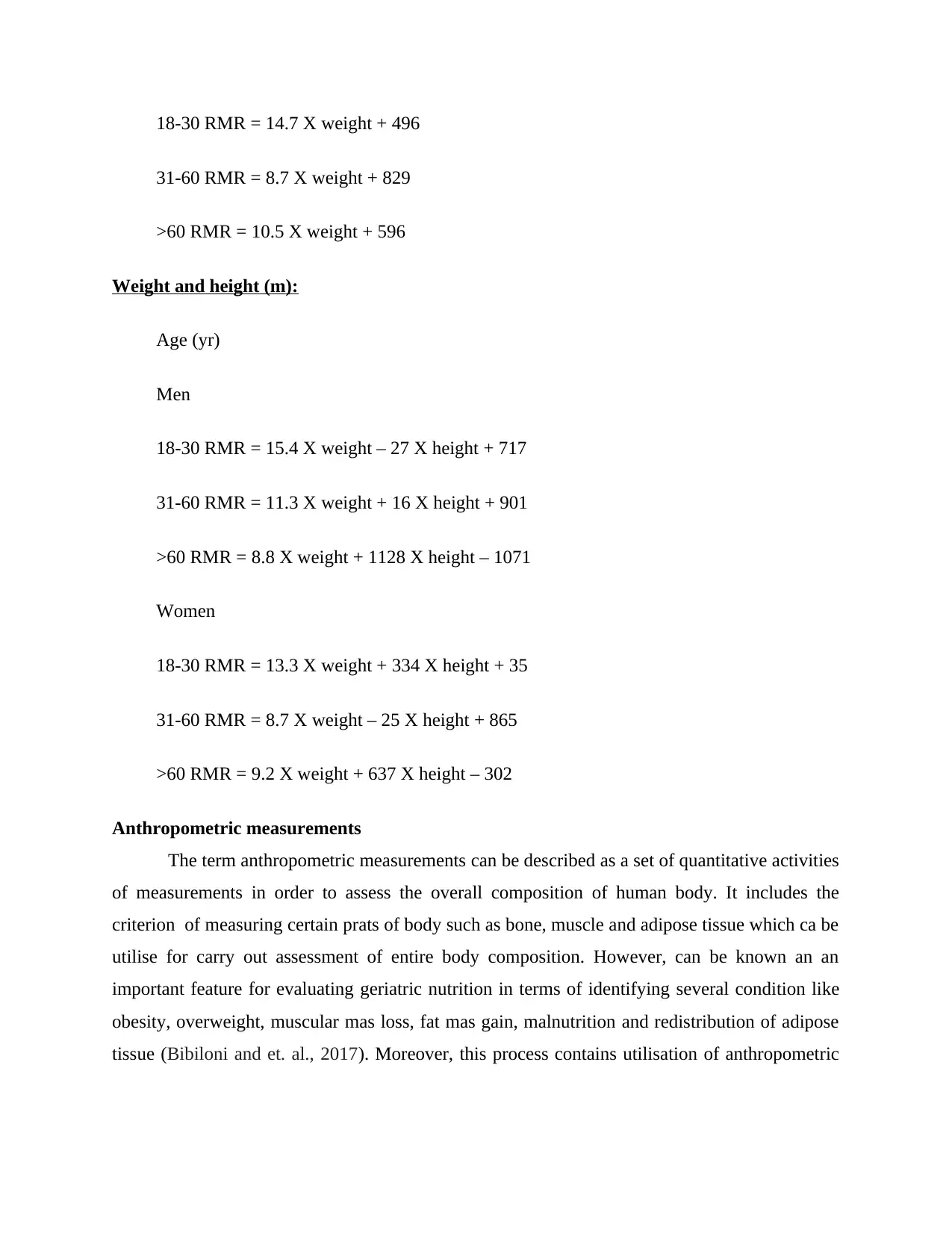
18-30 RMR = 14.7 X weight + 496
31-60 RMR = 8.7 X weight + 829
>60 RMR = 10.5 X weight + 596
Weight and height (m):
Age (yr)
Men
18-30 RMR = 15.4 X weight – 27 X height + 717
31-60 RMR = 11.3 X weight + 16 X height + 901
>60 RMR = 8.8 X weight + 1128 X height – 1071
Women
18-30 RMR = 13.3 X weight + 334 X height + 35
31-60 RMR = 8.7 X weight – 25 X height + 865
>60 RMR = 9.2 X weight + 637 X height – 302
Anthropometric measurements
The term anthropometric measurements can be described as a set of quantitative activities
of measurements in order to assess the overall composition of human body. It includes the
criterion of measuring certain prats of body such as bone, muscle and adipose tissue which ca be
utilise for carry out assessment of entire body composition. However, can be known an an
important feature for evaluating geriatric nutrition in terms of identifying several condition like
obesity, overweight, muscular mas loss, fat mas gain, malnutrition and redistribution of adipose
tissue (Bibiloni and et. al., 2017). Moreover, this process contains utilisation of anthropometric
31-60 RMR = 8.7 X weight + 829
>60 RMR = 10.5 X weight + 596
Weight and height (m):
Age (yr)
Men
18-30 RMR = 15.4 X weight – 27 X height + 717
31-60 RMR = 11.3 X weight + 16 X height + 901
>60 RMR = 8.8 X weight + 1128 X height – 1071
Women
18-30 RMR = 13.3 X weight + 334 X height + 35
31-60 RMR = 8.7 X weight – 25 X height + 865
>60 RMR = 9.2 X weight + 637 X height – 302
Anthropometric measurements
The term anthropometric measurements can be described as a set of quantitative activities
of measurements in order to assess the overall composition of human body. It includes the
criterion of measuring certain prats of body such as bone, muscle and adipose tissue which ca be
utilise for carry out assessment of entire body composition. However, can be known an an
important feature for evaluating geriatric nutrition in terms of identifying several condition like
obesity, overweight, muscular mas loss, fat mas gain, malnutrition and redistribution of adipose
tissue (Bibiloni and et. al., 2017). Moreover, this process contains utilisation of anthropometric
Paraphrase This Document
Need a fresh take? Get an instant paraphrase of this document with our AI Paraphraser
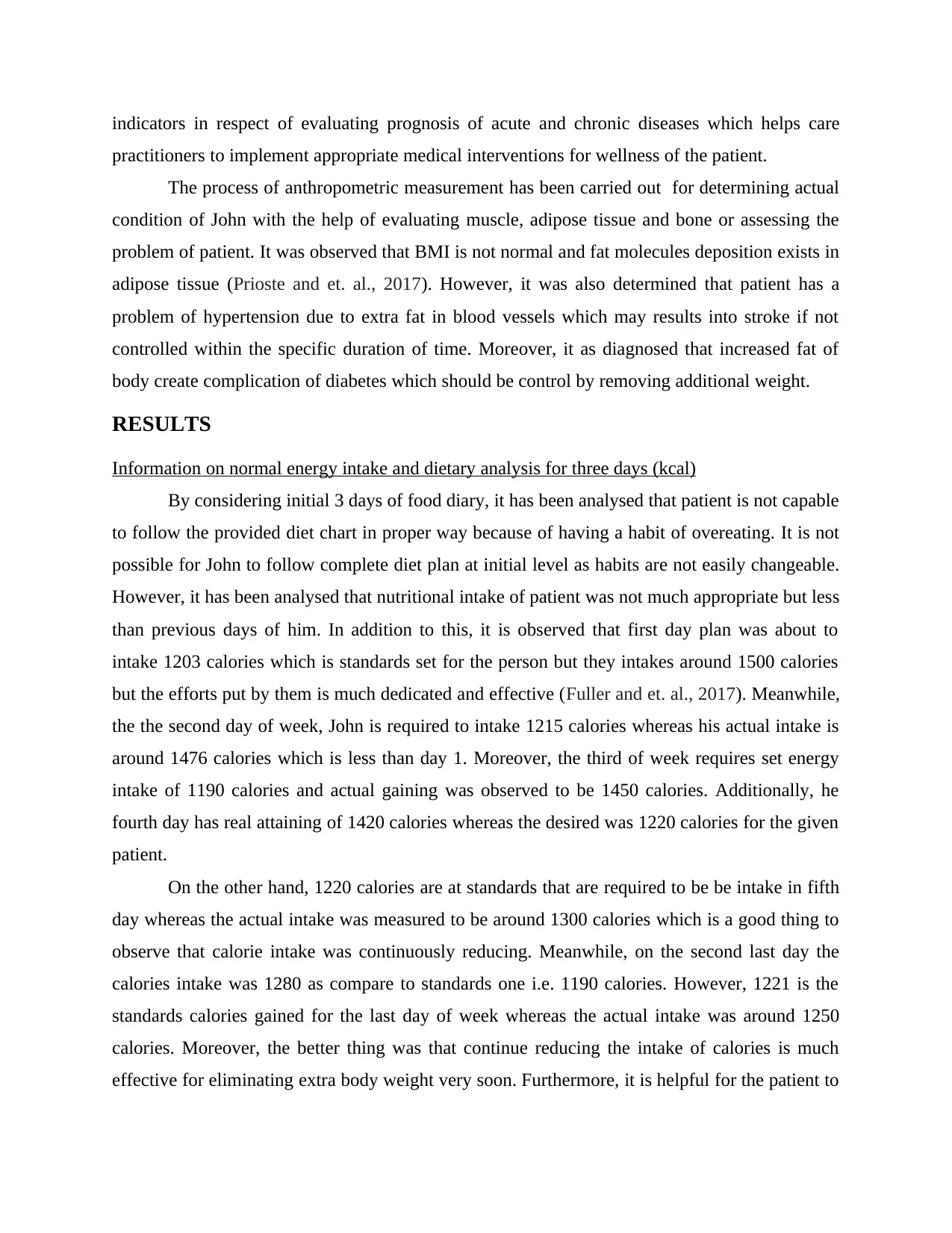
indicators in respect of evaluating prognosis of acute and chronic diseases which helps care
practitioners to implement appropriate medical interventions for wellness of the patient.
The process of anthropometric measurement has been carried out for determining actual
condition of John with the help of evaluating muscle, adipose tissue and bone or assessing the
problem of patient. It was observed that BMI is not normal and fat molecules deposition exists in
adipose tissue (Prioste and et. al., 2017). However, it was also determined that patient has a
problem of hypertension due to extra fat in blood vessels which may results into stroke if not
controlled within the specific duration of time. Moreover, it as diagnosed that increased fat of
body create complication of diabetes which should be control by removing additional weight.
RESULTS
Information on normal energy intake and dietary analysis for three days (kcal)
By considering initial 3 days of food diary, it has been analysed that patient is not capable
to follow the provided diet chart in proper way because of having a habit of overeating. It is not
possible for John to follow complete diet plan at initial level as habits are not easily changeable.
However, it has been analysed that nutritional intake of patient was not much appropriate but less
than previous days of him. In addition to this, it is observed that first day plan was about to
intake 1203 calories which is standards set for the person but they intakes around 1500 calories
but the efforts put by them is much dedicated and effective (Fuller and et. al., 2017). Meanwhile,
the the second day of week, John is required to intake 1215 calories whereas his actual intake is
around 1476 calories which is less than day 1. Moreover, the third of week requires set energy
intake of 1190 calories and actual gaining was observed to be 1450 calories. Additionally, he
fourth day has real attaining of 1420 calories whereas the desired was 1220 calories for the given
patient.
On the other hand, 1220 calories are at standards that are required to be be intake in fifth
day whereas the actual intake was measured to be around 1300 calories which is a good thing to
observe that calorie intake was continuously reducing. Meanwhile, on the second last day the
calories intake was 1280 as compare to standards one i.e. 1190 calories. However, 1221 is the
standards calories gained for the last day of week whereas the actual intake was around 1250
calories. Moreover, the better thing was that continue reducing the intake of calories is much
effective for eliminating extra body weight very soon. Furthermore, it is helpful for the patient to
practitioners to implement appropriate medical interventions for wellness of the patient.
The process of anthropometric measurement has been carried out for determining actual
condition of John with the help of evaluating muscle, adipose tissue and bone or assessing the
problem of patient. It was observed that BMI is not normal and fat molecules deposition exists in
adipose tissue (Prioste and et. al., 2017). However, it was also determined that patient has a
problem of hypertension due to extra fat in blood vessels which may results into stroke if not
controlled within the specific duration of time. Moreover, it as diagnosed that increased fat of
body create complication of diabetes which should be control by removing additional weight.
RESULTS
Information on normal energy intake and dietary analysis for three days (kcal)
By considering initial 3 days of food diary, it has been analysed that patient is not capable
to follow the provided diet chart in proper way because of having a habit of overeating. It is not
possible for John to follow complete diet plan at initial level as habits are not easily changeable.
However, it has been analysed that nutritional intake of patient was not much appropriate but less
than previous days of him. In addition to this, it is observed that first day plan was about to
intake 1203 calories which is standards set for the person but they intakes around 1500 calories
but the efforts put by them is much dedicated and effective (Fuller and et. al., 2017). Meanwhile,
the the second day of week, John is required to intake 1215 calories whereas his actual intake is
around 1476 calories which is less than day 1. Moreover, the third of week requires set energy
intake of 1190 calories and actual gaining was observed to be 1450 calories. Additionally, he
fourth day has real attaining of 1420 calories whereas the desired was 1220 calories for the given
patient.
On the other hand, 1220 calories are at standards that are required to be be intake in fifth
day whereas the actual intake was measured to be around 1300 calories which is a good thing to
observe that calorie intake was continuously reducing. Meanwhile, on the second last day the
calories intake was 1280 as compare to standards one i.e. 1190 calories. However, 1221 is the
standards calories gained for the last day of week whereas the actual intake was around 1250
calories. Moreover, the better thing was that continue reducing the intake of calories is much
effective for eliminating extra body weight very soon. Furthermore, it is helpful for the patient to
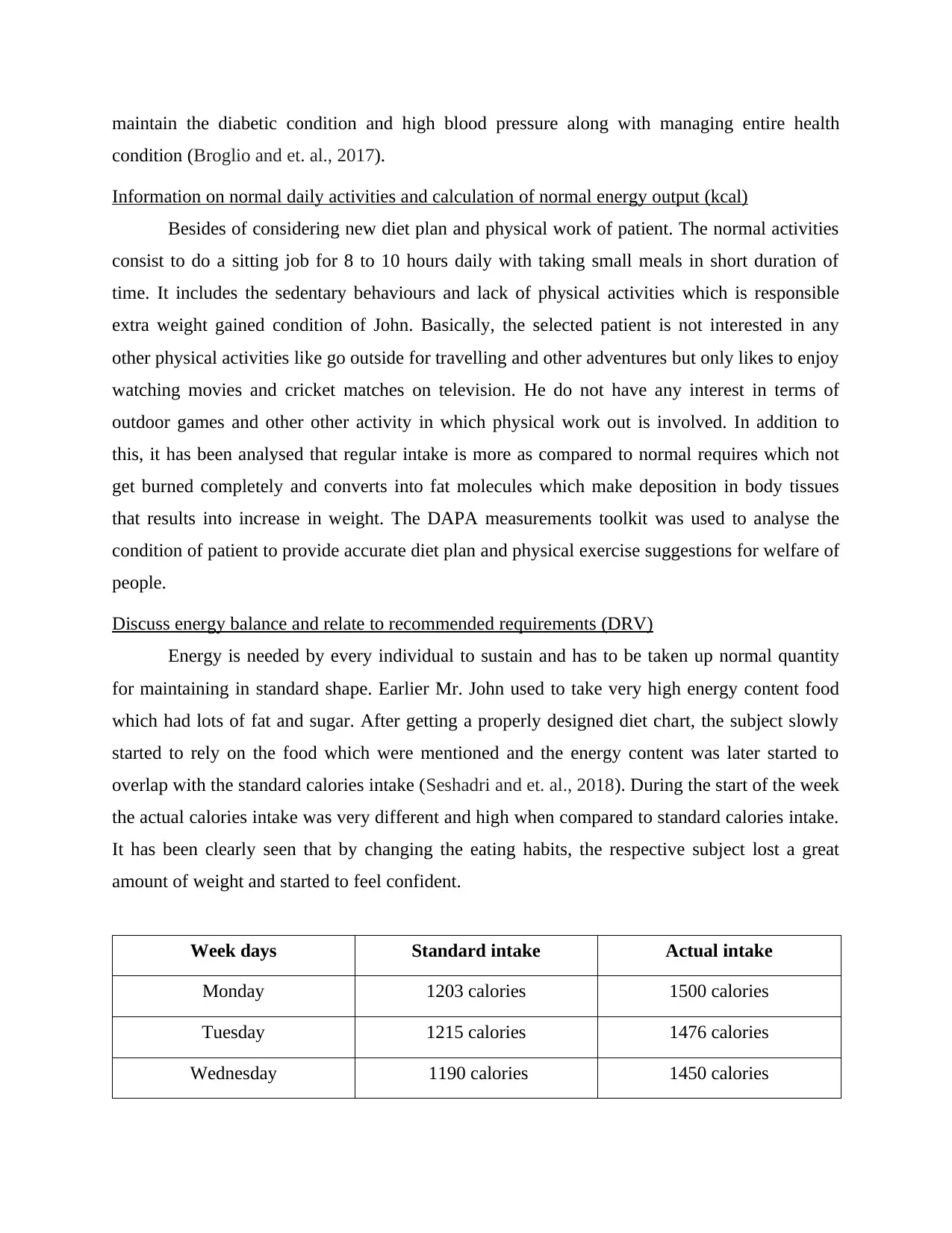
maintain the diabetic condition and high blood pressure along with managing entire health
condition (Broglio and et. al., 2017).
Information on normal daily activities and calculation of normal energy output (kcal)
Besides of considering new diet plan and physical work of patient. The normal activities
consist to do a sitting job for 8 to 10 hours daily with taking small meals in short duration of
time. It includes the sedentary behaviours and lack of physical activities which is responsible
extra weight gained condition of John. Basically, the selected patient is not interested in any
other physical activities like go outside for travelling and other adventures but only likes to enjoy
watching movies and cricket matches on television. He do not have any interest in terms of
outdoor games and other other activity in which physical work out is involved. In addition to
this, it has been analysed that regular intake is more as compared to normal requires which not
get burned completely and converts into fat molecules which make deposition in body tissues
that results into increase in weight. The DAPA measurements toolkit was used to analyse the
condition of patient to provide accurate diet plan and physical exercise suggestions for welfare of
people.
Discuss energy balance and relate to recommended requirements (DRV)
Energy is needed by every individual to sustain and has to be taken up normal quantity
for maintaining in standard shape. Earlier Mr. John used to take very high energy content food
which had lots of fat and sugar. After getting a properly designed diet chart, the subject slowly
started to rely on the food which were mentioned and the energy content was later started to
overlap with the standard calories intake (Seshadri and et. al., 2018). During the start of the week
the actual calories intake was very different and high when compared to standard calories intake.
It has been clearly seen that by changing the eating habits, the respective subject lost a great
amount of weight and started to feel confident.
Week days Standard intake Actual intake
Monday 1203 calories 1500 calories
Tuesday 1215 calories 1476 calories
Wednesday 1190 calories 1450 calories
condition (Broglio and et. al., 2017).
Information on normal daily activities and calculation of normal energy output (kcal)
Besides of considering new diet plan and physical work of patient. The normal activities
consist to do a sitting job for 8 to 10 hours daily with taking small meals in short duration of
time. It includes the sedentary behaviours and lack of physical activities which is responsible
extra weight gained condition of John. Basically, the selected patient is not interested in any
other physical activities like go outside for travelling and other adventures but only likes to enjoy
watching movies and cricket matches on television. He do not have any interest in terms of
outdoor games and other other activity in which physical work out is involved. In addition to
this, it has been analysed that regular intake is more as compared to normal requires which not
get burned completely and converts into fat molecules which make deposition in body tissues
that results into increase in weight. The DAPA measurements toolkit was used to analyse the
condition of patient to provide accurate diet plan and physical exercise suggestions for welfare of
people.
Discuss energy balance and relate to recommended requirements (DRV)
Energy is needed by every individual to sustain and has to be taken up normal quantity
for maintaining in standard shape. Earlier Mr. John used to take very high energy content food
which had lots of fat and sugar. After getting a properly designed diet chart, the subject slowly
started to rely on the food which were mentioned and the energy content was later started to
overlap with the standard calories intake (Seshadri and et. al., 2018). During the start of the week
the actual calories intake was very different and high when compared to standard calories intake.
It has been clearly seen that by changing the eating habits, the respective subject lost a great
amount of weight and started to feel confident.
Week days Standard intake Actual intake
Monday 1203 calories 1500 calories
Tuesday 1215 calories 1476 calories
Wednesday 1190 calories 1450 calories
⊘ This is a preview!⊘
Do you want full access?
Subscribe today to unlock all pages.

Trusted by 1+ million students worldwide
1 out of 20
Related Documents
Your All-in-One AI-Powered Toolkit for Academic Success.
+13062052269
info@desklib.com
Available 24*7 on WhatsApp / Email
![[object Object]](/_next/static/media/star-bottom.7253800d.svg)
Unlock your academic potential
Copyright © 2020–2025 A2Z Services. All Rights Reserved. Developed and managed by ZUCOL.



